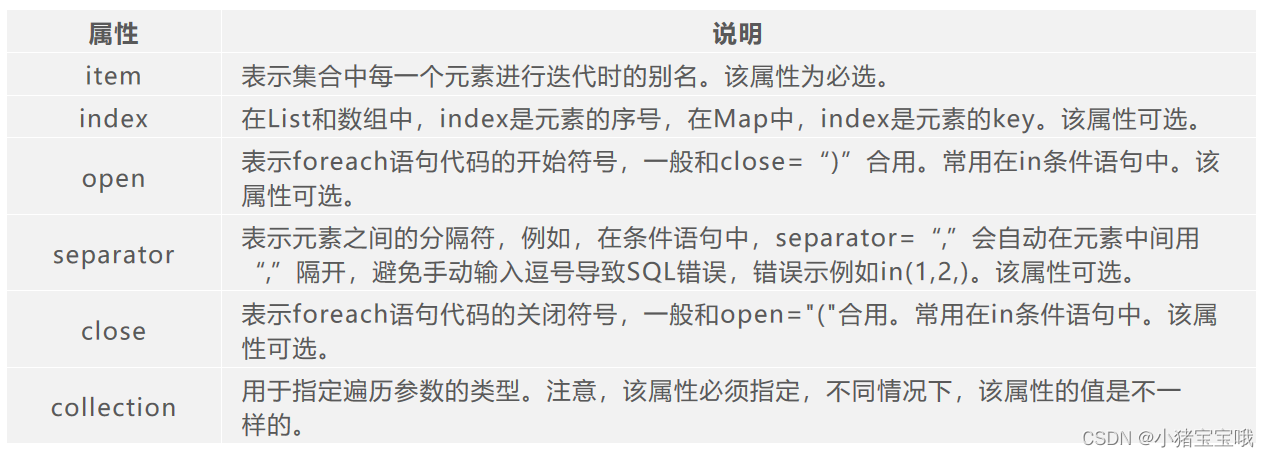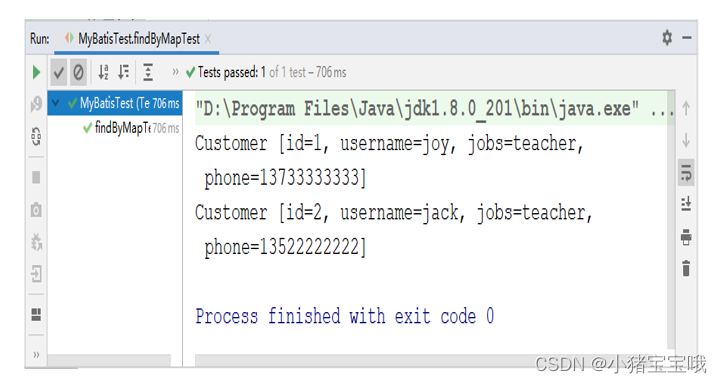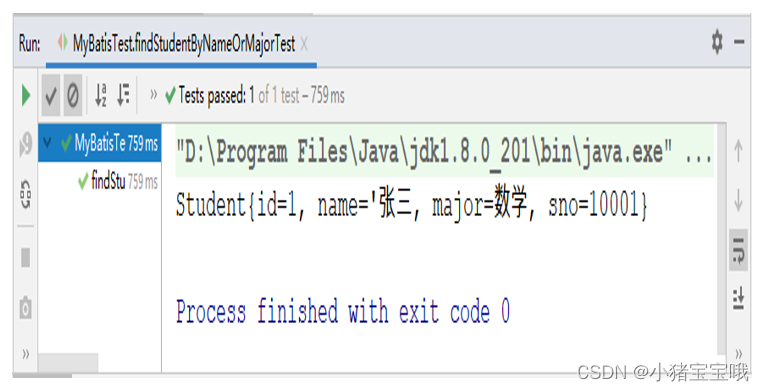-
第3章 动态SQL
目录/Contents
第3章 动态SQL
学习目标
掌握MyBatis中动态SQL元素的使用
掌握MyBatis的条件查询操作
掌握MyBatis的更新操作
掌握MyBatis的复杂查询操作
学习内容
1 动态SQL中的元素
1.1 使用动态SQL的好处
动态SQL是MyBatis的强大特性之一,MyBatis采用了功能强大的基于OGNL(Object Graph Navigation Language)的表达式来完成动态SQL。在MyBatis的映射文件中,开发人员可通过动态SQL元素灵活组装SQL语句,这在很大程度上避免了单一SQL语句的反复堆砌,提高了SQL语句的复用性。
1.2 动态SQL常用元素

2 条件查询操作
2.1
元素 元素的应用
在MyBatis中,元素是最常用的判断元素,它类似于Java中的if语句,主要用于实现某些简单的条件判断。在实际应用中,我们可能会通过某个条件查询某个数据。例如,要查找某个客户的信息,可以通过姓名或者年龄来查找客户,也可以不填写年龄直接通过姓名来查找客户,还可以都不填写而查询出所有客户,此时姓名和年龄就是非必须条件。类似于这种情况,在MyBatis中就可以通过 元素来实现。 根据客户姓名和年龄组合条件查询客户信息,使用元素编写该组合条件的动态SQL。
<!– 该xml文件中只列出了if元素的动态SQL--> <if test="username !=null and username !=‘’“> and username like concat('%',#{username}, '%') </if> <if test="jobs !=null and jobs !=‘’“> and jobs= #{jobs} </if>- 1
- 2
- 3
- 4
- 5
- 6
- 7
2.2
、 、 元素 使用场景
在使用元素时,只要test属性中的表达式为true,就会执行元素中的条件语句,但是在实际应用中,有时只需要从多个选项中选择一个去执行。
例如下面的场景:“当客户名称不为空,则只根据客户名称进行客户筛选;当客户名称为空,而客户职业不为空,则只根据客户职业进行客户筛选。当客户名称和客户职业都为空,则要求查询出所有电话不为空的客户信息。”
针对上面情况,使用元素进行处理是不合适的。MyBatis提供了 、 、 元素进行处理,这三个元素往往组合在一起使用,作用相当于Java语言中的if…else if…else。 <!-- 只展示三个组合元素的部分--> <choose> <when test="username !=null and username !=''"> and username like concat('%',#{username}, '%') </when> <when test="jobs !=null and jobs !=''"> and jobs= #{jobs} </when> <otherwise>and phone is not null</otherwise> </choose>- 1
- 2
- 3
- 4
- 5
- 6
- 7
- 8
- 9
- 10
2.3
、 元素 使用场景
在映射文件中,编写的SQL后面加入了“where 1=1”的条件的话,既保证了where后面的条件成立,又避免了where后面第一个词是and或者or之类的关键字。
例如下面这条Mybatis拼接出的SQL语句是不正确的。
select * from t_customer where and username like concat(‘%’,?, ‘%’) and jobs = #{jobs}
上述SQL语句中,where后直接跟的是and,这在运行时会报SQL语法错误,针对这种情况,可以使用MyBatis提供的元素和元素进行处理。元素 <select id="findCustomerByNameAndJobs" parameterType="com.itheima.pojo.Customer" resultType="com.itheima.pojo.Customer"> select * from t_customer <where> <if test="username !=null and username !=''"> and username like concat('%',#{username}, '%')</if> <if test="jobs !=null and jobs !=''"> and jobs= #{jobs}</if> </where></select>- 1
- 2
- 3
- 4
- 5
- 6
- 7
- 8
- 9
- 10
上述代码配置中,
元素会自动判断由组合条件拼装的SQL语句,只有 元素内的某一个或多个条件成立时,才会在拼接SQL中加入where关键字,否则将不会添加;即使where之后的内容有多余的“AND”或“OR”, 元素也会自动将他们去除。 元素
元素用于删除多余的关键字,它可以直接实现元素的功能。元素包含4个属性。
prefix 指定给SQL语句增加的前缀
prefixOverrides 指定SQL语句中要去掉的前缀字符串
suffix 指定给SQL语句增加的后缀
suffixOverrides 指定SQL语句中要去掉的后缀字符串<select id="findCustomerByNameAndJobs" parameterType="com.itheima.pojo.Customer" resultType="com.itheima.pojo.Customer"> select * from t_customer <trim prefix="where" prefixOverrides="and" > <if test="username !=null and username !=''"> and username like concat('%',#{username}, '%')</if> <if test="jobs !=null and jobs !=''"> and jobs= #{jobs}</if></trim> </select>- 1
- 2
- 3
- 4
- 5
- 6
- 7
- 8
- 9
- 10
上述配置代码中,
元素的作用是去除一些多余的前缀字符串,它的prefix属性代表的是语句的前缀(where),而prefixOverrides属性代表的是需要去除的前缀字符串(SQL中的“AND”或“OR”)。 3 更新操作
3.1
元素 元素使用场景
在Hibernate框架中,如果想要更新某一个对象,就需要发送所有的字段给持久化对象,然而在实际应用中,大多数情况下都是更新某一个或几个字段。如果更新的每一条数据都要将其所有的属性都更新一遍,那么执行效率是非常差的。为了解决更新数据的效率问题,MyBatis提供了元素。元素主要用于更新操作,它可以在动态SQL语句前输出一个SET关键字,并将SQL语句中最后一个多余的逗号去除。元素与元素结合可以只更新需要更新的字段。<update id="updateCustomerBySet" parameterType="com.itheima.pojo.Customer">update t_customer <set> <if test="username !=null and username !=''"> username=#{username},</if> <if test="jobs !=null and jobs !=''"> jobs=#{jobs},</if> <if test="phone !=null and phone !=''">phone=#{phone},</if> </set> where id=#{id} </update>- 1
- 2
- 3
- 4
- 5
- 6
- 7
- 8
元素字段非空
在映射文件中使用元素和 元素组合进行update语句动态SQL组装时,如果 元素内包含的内容都为空,则会出现SQL语法错误。因此,在使用 元素进行字段信息更新时,要确保传入的更新字段不能都为空。 使用
元素更新
除了使用元素外,还可以通过 元素来实现更新操作。其中, 元素的prefix属性指定要添加的 元素所包含内容的前缀为set,suffixOverrides属性指定去除的 元素所包含内容的后缀为逗号 。 4 复杂查询操作
4.1
元素的属性 
4.2
属性的取值 在遍历参数时,
属性的值是必须指定的。不同情况下,该属性的取值也是不一样的,主要有以下三种情况:List类型、数值类型、Map类型。
若入参为单参数且参数类型是一个List,collection属性值为list。
若入参为单参数且参数类型是一个数组,collection属性值为array。
若传入参数为多参数,就需要把参数封装为一个Map进行处理,collection属性值为Map。若传入参数为多参数,就需要把参数封装为一个Map进行处理,collection属性值为Map。4.3
元素迭代数组 实现入参为数组类型的遍历
例如,要从数据表t_customer中查询出id为1、2、3的客户信息,就可以利用数组作为参数,存储id的属性值1、2、3,并通过元素迭代数组完成客户信息的批量查询操作。 在映射文件CustomerMapper.xml中,添加使用元素迭代数组执行批量查询操作的动态SQL。
<select id="findByArray" parameterType="java.util.Arrays" resultType="com.itheima.pojo.Customer">select * from t_customer where id in <foreach item="id" index="index" collection="array" open="(" separator="," close=")"> #{id} </foreach> select>- 1
- 2
- 3
- 4
- 5
- 6
在测试类MyBatisTest中,编写测试方法findByArrayTest()方法,实现客户信息的批量查询。
public void findByArrayTest() { SqlSession session = MyBatisUtils.getSession(); // 获取SqlSession Integer[] roleIds = {2,3}; // 创建数组,封装查询id // 执行SqlSession的查询方法,返回结果集 List<Customer> customers = session.selectList("com.itheima.mapper" + ".CustomerMapper.findByArray", roleIds); for (Customer customer : customers) {System.out.println(customer);} session.close(); }- 1
- 2
- 3
- 4
- 5
- 6
- 7
- 8
- 9
执行MyBatisTest测试类的findByArrayTest()方法,控制台会输出结果。

4.4
元素迭代List 元素迭代List的实现步骤具体如下。
在映射文件CustomerMapper.xml中,添加使用元素迭代List集合执行批量查询操作的动态SQL。<select id="findByList" parameterType="java.util.Arrays" resultType="com.itheima.pojo.Customer"> select * from t_customer where id in <foreach item="id" index="index" collection="list" open="(" separator="," close=")"> #{id} </foreach> </select>- 1
- 2
- 3
- 4
- 5
- 6
- 7
- 8
在测试类MyBatisTest中,编写测试方法findByListTest(),用于批量查询客户信息。
public void findByListTest() { SqlSession session = MyBatisUtils.getSession(); List<Integer> ids=new ArrayList<Integer>(); ids.add(1); ids.add(2); List<Customer> customers = session.selectList("com.itheima.mapper" + ".CustomerMapper.findByList", ids); for (Customer customer : customers) {System.out.println(customer); } session.close(); }- 1
- 2
- 3
- 4
- 5
- 6
- 7
- 8
- 9
执行MyBatisTest测试类的findByListTest()方法,控制台会输出结果。

4.5
元素迭代Map 下面通过一个案例演示如何使用元素迭代Map集合,实现多参数入参查询操作,案例具体实 现步骤如下。
在映射文件CustomerMapper.xml中,添加使用元素迭代Map集合执行批量查询操作的动态SQL。<select id="findByMap" parameterType="java.util.Map" resultType="com.itheima.pojo.Customer"> select * from t_customer where jobs=#{jobs} and id in <foreach item="roleMap" index="index" collection="id" open="(" separator="," close=")"> #{roleMap} </foreach> </select>- 1
- 2
- 3
- 4
- 5
- 6
在测试类MyBatisTest中,编写测试方法findByMapTest(),用于批量查询客户信息。
public void findByMapTest() { SqlSession session = MyBatisUtils.getSession(); List<Integer> ids=new ArrayList<Integer>(); ids.add(1); ids.add(2); ids.add(3); Map<String,Object> conditionMap = new HashMap<String, Object>(); conditionMap.put(“id",ids); conditionMap.put("jobs","teacher"); List<Customer> customers = session.selectList("com.itheima.mapper" + ".CustomerMapper.findByMap", conditionMap); for (Customer customer : customers) { System.out.println(customer);} session.close(); }- 1
- 2
- 3
- 4
- 5
- 6
- 7
- 8
- 9
- 10
- 11
执行MyBatisTest测试类的findByMapTest()方法,控制台会输出结果。

5 案例:学生信息查询系统
5.1 需求
多条件查询
当用户输入的学生姓名不为空,则只根据学生姓名进行学生信息的查询;
当用户输入的学生姓名为空,而学生专业不为空,则只根据学生专业进行学生的查询;
单条件查询
查询出所有id值小于5的学生的信息;5.2 项目搭建
创建一个名称为mybatis-demo03的项目
5.3 数据准备
在名称为mybatis的数据库中,创建一个dm_student表,并插入几条测试数据。
USE mybatis; CREATE TABLE dm_student( id int(32) PRIMARY KEY AUTO_INCREMENT, name varchar(50), major varchar(50), sno varchar(16) ); # 插入7条数据,其他省略 INSERT INTO dm_student VALUES ('1', '张三', '数学', '10001');- 1
- 2
- 3
- 4
- 5
- 6
- 7
- 8
5.4 POJO类准备
创建持久化类Student,在类中声明id、name、major和sno属性,以及属性对应的getter/setter方法。
public class Student {// 定义变量主键id,姓名name,专业major,学号sno private Integer id; private String name; private String major; private String sno; // 省略getter/setter方法 @Override public String toString() { return “Student{” + “id=” + id + “, name=‘” + name + “, major=" + major + ", sno=" + sno + '}';}}- 1
- 2
- 3
- 4
- 5
- 6
- 7
- 8
5.5 创建映射文件
创建映射文件StudentMapper.xml,编写根据学生姓名和专业组合成的条件查询学生信息的动态SQL。
<mapper namespace="com.itheima.mapper.StudentMapper"> <select id=“findStudentByNameAndMajor” parameterType=“com.itheima.pojo.Student” resultType="com.itheima.pojo.Student"> select * from dm_student where 1=1 <choose> <when test="name !=null and name !=''"> and name like concat('%',#{name}, '%')</when> <when test="major !=null and major !=''"> and major= #{major}</when> <otherwise> and sno is not null</otherwise> </choose> </select> </mapper>- 1
- 2
- 3
- 4
- 5
- 6
- 7
- 8
- 9
5.6 修改mybatis-config.xml核心配置文件
在mybatis-config.xml映射文件的元素下添加StudentMapper.xml映射文件路径的配置,用于将StudentMapper.xml映射文件加载到程序中。具体配置代码如下。
<mapper resource="com/itheima/mapper/StudentMapper.xml"/>- 1
5.7 编写MyBatisUtils工具类
创建MyBatisUtils工具类,该类用于封装读取配置文件信息的代码。
public class MyBatisUtils { private static SqlSessionFactory sqlSessionFactory = null; static { try { Reader reader = Resources.getResourceAsReader(“mybatis-config.xml”); SqlSessionFactory sqlSessionFactory = new SqlSessionFactoryBuilder().build(reader); } catch (Exception e) {e.printStackTrace();} } public static SqlSession getSession() { return sqlSessionFactory.openSession();} }- 1
- 2
- 3
- 4
- 5
- 6
- 7
- 8
- 9
5.8 编写测试方法
在测试类MyBatisTest中,编写测试方法findStudentByNameOrMajorTest(),该方法用于根据学生姓名或专业查询学生信息。
public void findStudentByNameOrMajorTest() { SqlSession session=MyBatisUtils.getSession(); Student student=new Student(); student.setName("张三"); student.setMajor("英语"); List<Student> students = session.selectList("com.itheima.mapper" + ".StudentMapper.findStudentByNameAndMajor",student); for (Student student2 : students) {System.out.println(student2);} session.close(); }- 1
- 2
- 3
- 4
- 5
- 6
- 7
- 8
- 9
- 10
5.9 查看运行结果
执行测试类MyBatisTest的findStudentByNameOrMajorTest()方法,控制台会输出结果。

5.10 多条件查询案例结果分析
由输出结果分析可知,在查询学生信息时,虽然同时传入了姓名和专业两个查询条件,但MyBatis所生成的SQL只是动态组装了学生姓名条件进行查询。如果将案例代码中的student.setName(“张三”)删除或者注释掉,使SQL只按专业进行查询。再次执行findStudentByNameOrMajorTest()方法,MyBatis生成的SQL会组装学生职业进行条件查询,同样查询出了学生信息。如果学生姓名和专业都为空,MyBatis的SQL便会组装元素中的SQL片段进行条件查询。
5.11 修改映射文件
在映射文件StudentMapper.xml中的元素下,编写查询所有id值小于5的学生信息的动态SQL。
<select id="findByList" parameterType="java.util.List" resultType="com.itheima.pojo.Student"> select * from dm_student where id in <foreach item="id" index="index" collection="list" open="(" separator="," close=")"> #{id} </foreach> </select>- 1
- 2
- 3
- 4
- 5
- 6
- 7
- 8
5.12 编写测试方法
在测试类MyBatisTest中,编写测试方法findByListTest()。
public void findByListTest() { SqlSession session = MyBatisUtils.getSession(); List<Integer> ids=new ArrayList<Integer>(); for(int i =1;i<5;i++){ ids.add(i);} List<Student> students = session.selectList("com.itheima.mapper" + ".StudentMapper.findByList", ids); for (Student student : students) { System.out.println(student);} session.close(); }- 1
- 2
- 3
- 4
- 5
- 6
- 7
- 8
- 9
- 10
-
相关阅读:
Swin Transformer、ViT作者等共话:好的基础模型是CV 研究者的朴素追求
手机联系人恢复:3个方法的选择和比较
我要写整个中文互联网界最牛逼的JVM系列教程 | 「JVM与Java体系架构」章节:JVM的位置
FFmpeg编译支持x264/openH264/dash
用Python制造雪景图,体验 “ 人工下雪 ” 得快乐~
mongodb-gridfs下载文件报Sort exceeded memory limit of 104857600 bytes异常
a标签的下载
SWT/ANR问题--ANR/JE引发SWT
<二>掌握构造函数和析构函数
关于异常的方方面面
- 原文地址:https://blog.csdn.net/qq_42670540/article/details/126573741